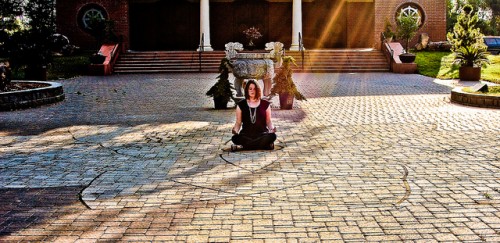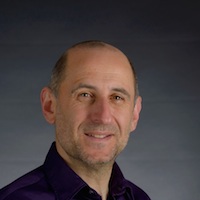By the time I hit my 30s, I was completely stressed out.
I ran my own business, was overworked, didn’t exercise and ate too many carbs. Working days merged into weekends—I was heading for burn out and the edge of the precipice.
Luckily I was rescued by a magic remedy: meditation. It changed my life.
A true cynic regarding anything slightly alternative, I had an out-of-the-blue spiritual experience: a healer cured a longstanding back problem literally overnight. This stunned me. I was rational but this was not. Life then changed at a pace—healthy food, meditation, less alcohol and then no alcohol. I was being driven in a new direction: I met dubious “new age” types who told me that “we are all one,” had Dan Brown types of experiences in Egypt and met a 91-year-old guru from India.
This guru, Paramahamsa Hariharananda, taught me Kriya Yoga, which in modern day speak is the ancient meditation technique of breath mindfulness, taught to Gandhi and lauded by Steve Jobs. The guru told me that “with sincere practice I could reduce my stress levels and extreme calmness would come in two minutes’ time!”
I was skeptical but decided to believe him and practice for just 15 minutes each day. It was the best investment I ever made. I soon discovered that meditation was like a superfood for the mind. When stress came now, I had a powerful healthy antidote that actually worked. Meditation gave me an advantage that everyone looking for success is after—more focus, more endurance and drive to achieve our goals.
Be assured I am not a touchy feely new-age yogi. If it helped a non-believer like me it can help you too!
What is meditation?
Meditation takes us into the space between two thoughts. It’s easy to practice and regardless of our beliefs, it relaxes the mind by calming the breath.
There are countless scientific studies showing the huge benefits of meditation for the mind, the body and our general wellbeing. It’s been around for thousands of years, has no negative side effects and our brain power is enhanced and not ruined.
Meditation helps relieve depression, stress and many illnesses, so you have nothing to lose and everything to gain. Authentic meditation techniques oxygenate the brain and body. The more oxygen, the better our health. In addition, with more oxygen and activation of the pineal and pituitary glands, the meditator can feel a natural high within minutes.
But, like anything else, it takes practice and getting high to escape the world is not the goal. The goal of meditation is to feel our true nature as a loving human being and to develop calmness, contentment and success in whatever path we choose. By meditating for just one percent of the day, the other 99 percent becomes more fulfilling.
You’re too busy to meditate?
We manage to find plenty of time to worry each day, so we can also find the time to do something good for ourselves.
There’s no need to go on a 10-day silent retreat to try meditation. I am against this approach for beginners—too many quit and the ones that don’t soon slip back into their old routine. Retreats are of benefit but not if the student goes away and doesn’t meditate even for a few minutes each day.
The good news is that according to the ancient text, Yoga Vasishta, the great sage Vasishta states that just 13 seconds of meditation has the same auspiciousness as giving away a valuable possession to charity; 101 seconds of meditation gives the same merit as performing a sacred rite and 12 minutes of meditation multiplies the merit 1,000 fold.
Meditation brings gain with daily practice.
How to meditate
Luckily, meditation works even if the mind is busy or if change is not apparent immediately.
There are, of course, many paths up the mountain, but the simplest and most powerful way to meditate is to watch our breath and ignore our thoughts. The breath is the most powerful mantra of all to focus on during meditation and throughout the day.
Yogis breathe in and out of the nostrils. Why? Firstly, the hairs in the nose act as an important filter when we breathe. Secondly, it makes the mind calmer. Thirdly, if the mouth is closed you cannot express negativities to others!
Tangible progress comes by observing the natural flow of the breath through the nostrils without controlling it and by ignoring our negative thoughts and actioning the positive ones.
How to begin and when to practice
I find it’s beneficial to meditate at the same time every day and stick to it. I prefer mornings, after a shower when the body is warm and before I eat breakfast, but really there’s never a bad time.
A bus or a train journey to work is also a good place to practice. It helps to choose a quiet place without background music and to sit on a chair or cross-legged on the floor with the spine straight and the chin slightly down. By keeping the chin down, the thyroid is slightly activated to keep us awake.
Close the eyes mouth and slowly breathe in and out of your nose. There’s no need to hold our breath or breathe with discomfort. Just be aware of the breath. The key is to focus on the breath in six of the main chakras.
Start by focusing at the center of the forehead. Observe inside. Just watch the inhalation and exhalation. Be relaxed. Calmness will come. Focus there. Don’t be concerned about any thoughts.
After a few minutes, move your attention down to the throat area, again a couple of inches inside. Watch the breath again.
Then follow this process by observing inside the center of the chest, the belly button area, genital area and at the bottom of the spine.
At each chakra, observe a couple of inches inside at the front of the spine for anywhere between two to five minutes depending on how much time you have.
After some time, slowly open your eyes while still watching the breath. Repeat as often as you can.
Twice per day is great or when stress comes take a few moments to meditate.
Can something so simple really bring benefit? See for yourself and make it part of your daily routine. Enjoy your meditation and if you want to learn more, then find an experienced teacher. I will leave you to contemplate on the words of the great yogi Paramahamsa Hariharananda:
“Breath mastery is self mastery. As is the breath so is the mind; as is the mind so are you.”
Love elephant and want to go steady?
Sign up for our (curated) daily and weekly newsletters!
Apprentice Editor: Jamie Khoo/Editor: Catherine Monkman
Photo: Britt-knee/Flickr Creative Commons












Read 0 comments and reply